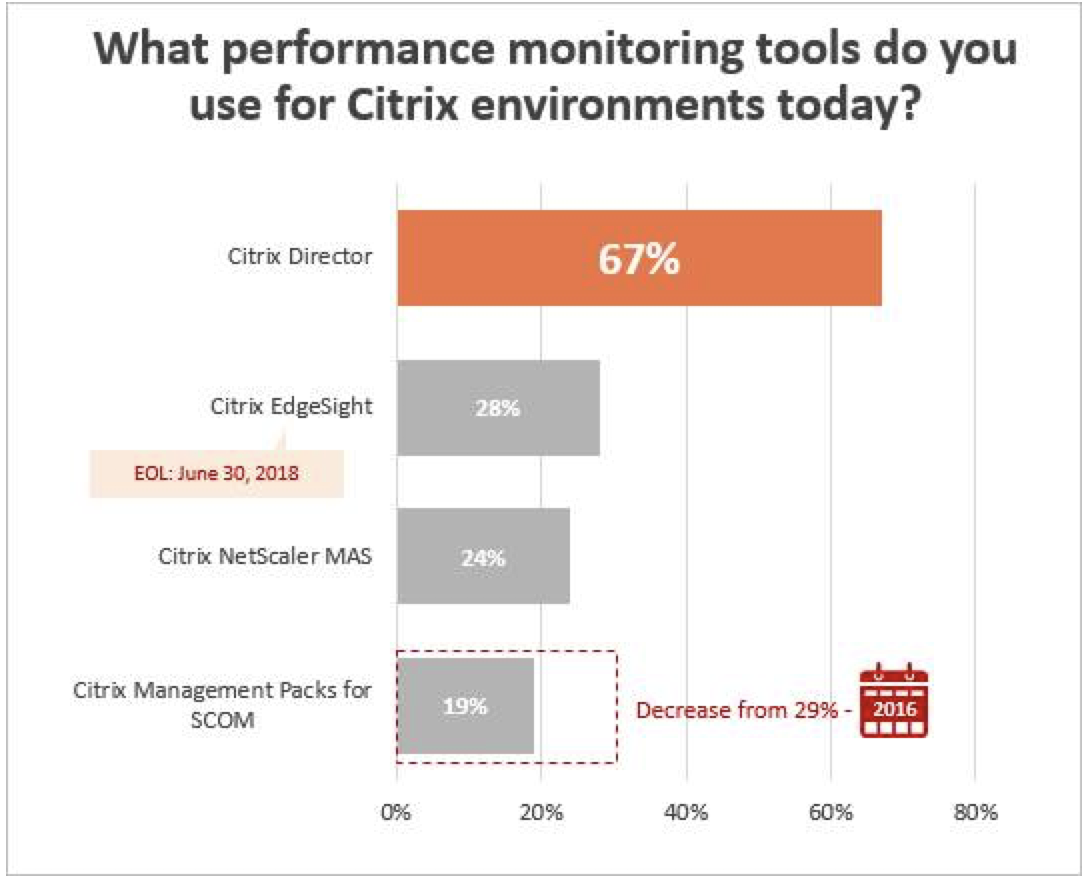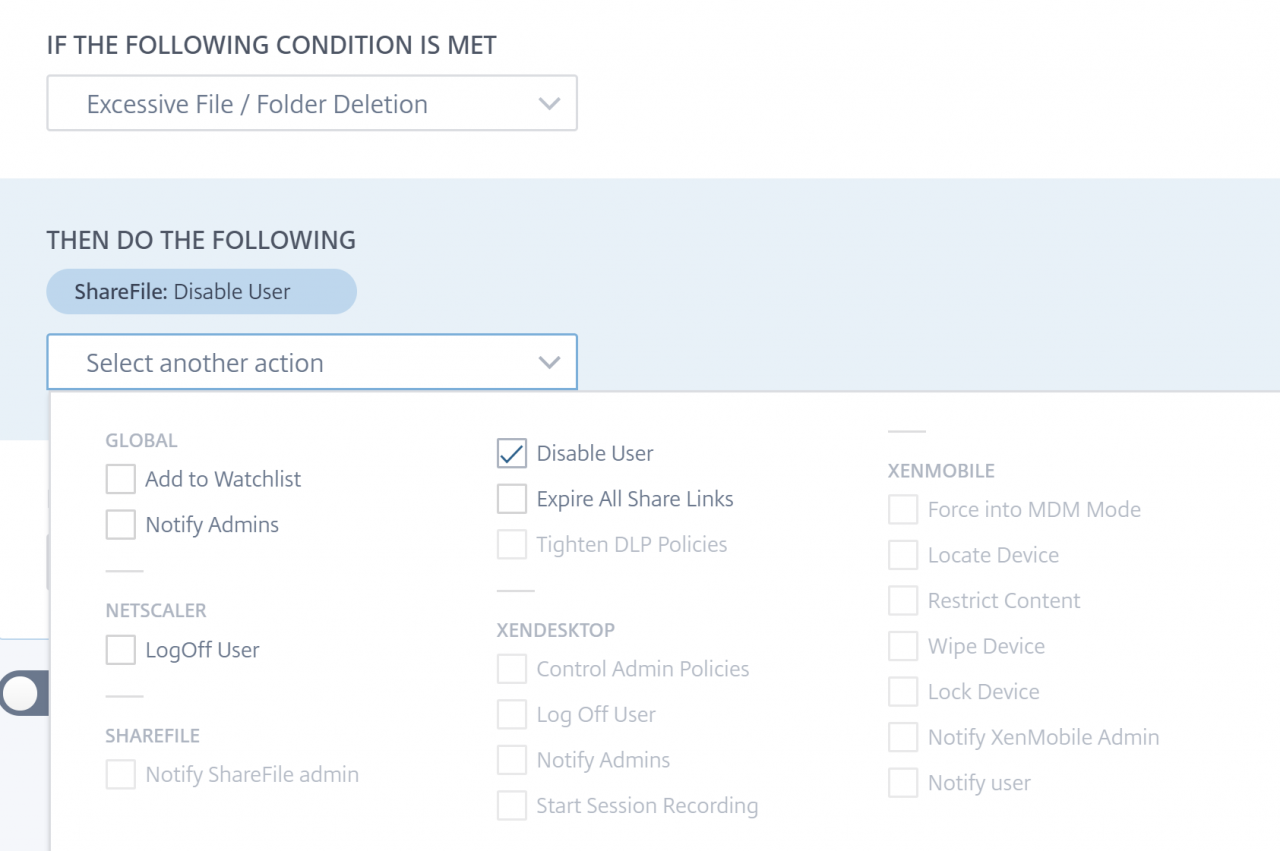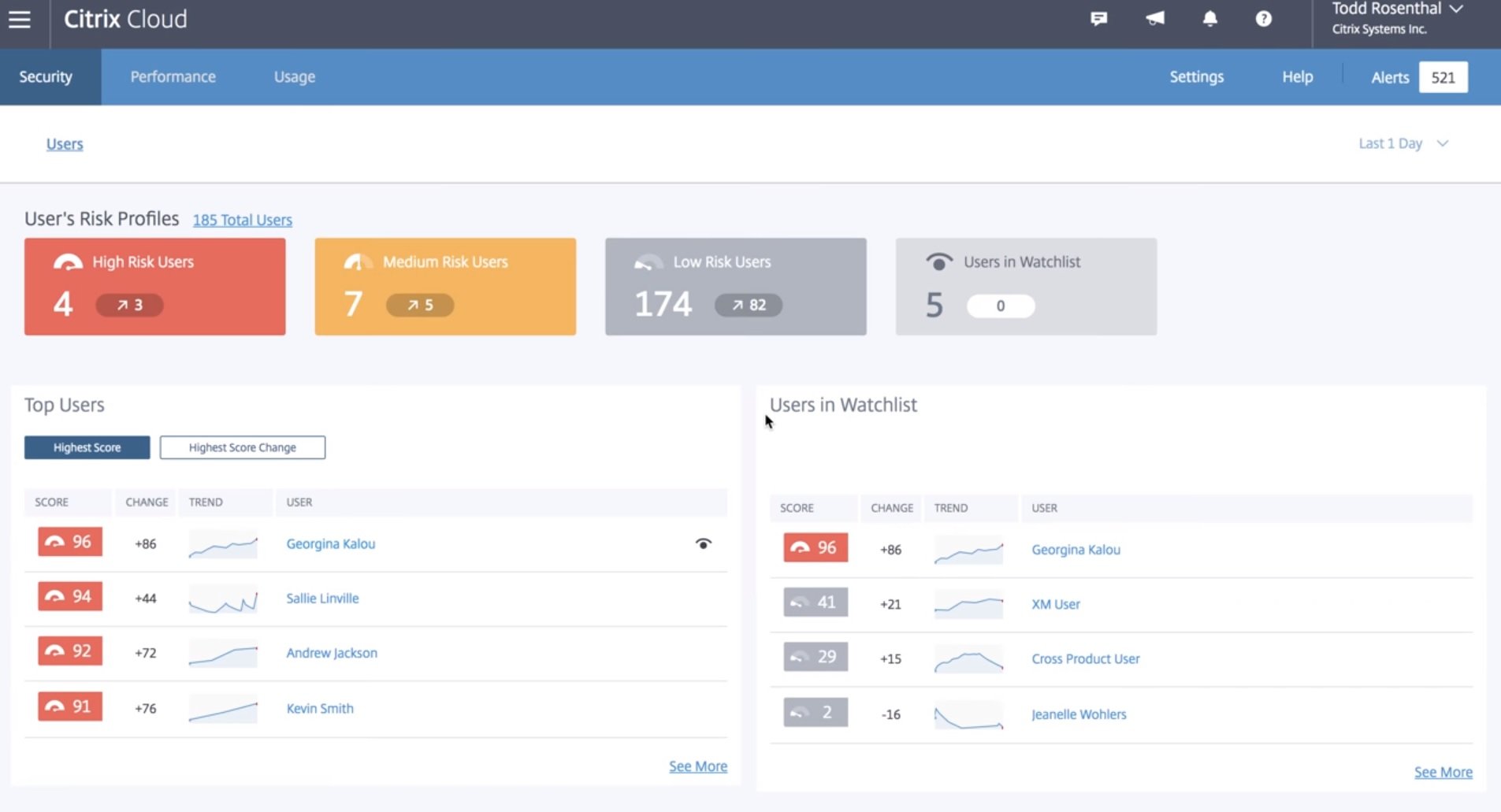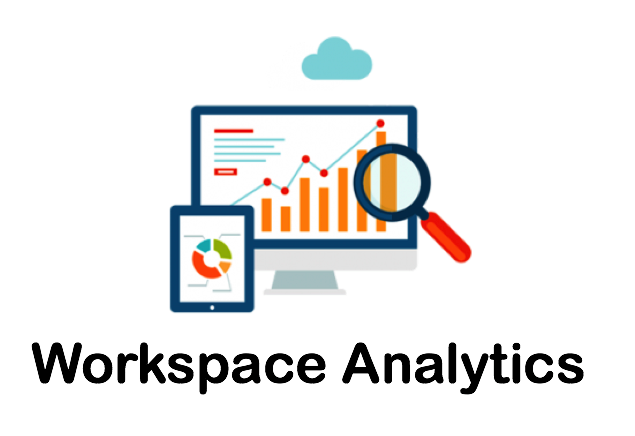
Analyzing and Monitoring the Citrix Digital Workspace: What are My Built-in Options? Why Do I Need Third-Party Monitoring Tools?
From an IT perspective – you always want to gather statistics to get better insights into what happens in your Workspace environment. Administrators are responsible for the performance and need to track faults proactively. Next, to performance monitoring tools, analytics comes in place – which is a new approach to analyzing the end-user behavior on suspicious activities. It adds security and operations whereby the new Privacy law, called GDPR expands this user monitor software with essential insights to track down the user behavior.
Monitoring tools for Citrix environments have always attracted attention. For example, at Citrix Synergy, sessions around monitoring have always been very well attended. With XenApp 6.5 reaching EOL and EdgeSight fading away, this space is getting even more attention. In this blog, we will discuss what Citrix monitoring options exist out there and how far and deep they go into monitoring XenApp and XenDesktop environments and where third-party monitoring tools fit in.
Also, there are much more tools on the market, besides the built-in ones (such as Analytics, MAS, and Director…) from Citrix. Some are free, some paid, and you probably don’t (yet) know the differences between those tools. They all have advantages and fill in gaps that Citrix can’t deliver at this moment…
This article will hopefully help you to make a decision which tool will best fit in your use case. I’ll share the tools that I’m using these days which help me to get a better understanding of the performance of my environment.
Enjoy reading!
Table of Contents
Click on the title to forwarded in the article:
- Citrix Migration 2018 survey results
- What are the built-in Citrix monitoring tools that are available today?
- What about monitoring of Citrix StoreFront, PVS, License server, WEM, XenMobile and ShareFile?
- What capabilities are needed for Citrix admins for performance troubleshooting, going beyond what native Citrix tools provide?
- What third-party tools should I look at for Citrix performance monitoring?
- Is monitoring mainly about troubleshooting?
2018 Citrix Migration Survey Results: Adoption of Citrix Monitoring Tools
2018 Citrix Migration Survey conducted by eG Innovations and DABCC.com across 795 Citrix professionals reveals that amongst the built-in Citrix tools, Director is the more popular one given the migration trend to XenApp and XenDesktop 7.x. Use of Citrix EdgeSight is reducing rapidly because of impending EOL on Jun 30, 2018. While NetScaler MAS is gaining popularity, we can see that Microsoft SCOM Management Packs have seen a dip in adoption.
Another interesting trend is the adoption of third-party monitoring tools for performance management of Citrix environments. We can see from the below stats that Citrix professionals are using third-party infrastructure monitoring tools for monitoring their supporting infrastructure, and third-party Citrix monitoring tools to get deeper and more comprehensive visibility into their Citrix environments, which they don’t get with built-in Citrix tools.
Get access to the full survey 2018 Citrix migration survey results here: https://www.eginnovations.com/Citrix-Migration-Trends
The rest of the article below will focus on understanding the extent of capabilities offered by built-in Citrix tools. We will also see some limitations of these tools, and how Citrix admins can benefit from third-party Citrix monitoring tools for advanced monitoring and troubleshooting capabilities.
What are the built-in Citrix monitoring tools that are available today?
Citrix Director, MAS, Citrix Management Packs for SCOM and Citrix Analytics.
Director is a session-level monitoring solution. It offers logon time breakdown for XenApp and XenDesktop. Reports on machine failures, VDA registration failures. Admins can drill into specific user sessions and see bandwidth usage on virtual channels. … It also provides ways to control a session – send a message, take a screenshot, logoff the user, kill a process etc. Director is also available as part of Citrix Cloud.
What about licensing
Included in all the Citrix XenApp and XenDesktop- virtual Apps and Desktops licenses. Platinum license has more capabilities.
Note: Another great article, written by Rory Monaghan on Citrix Director can be found here.
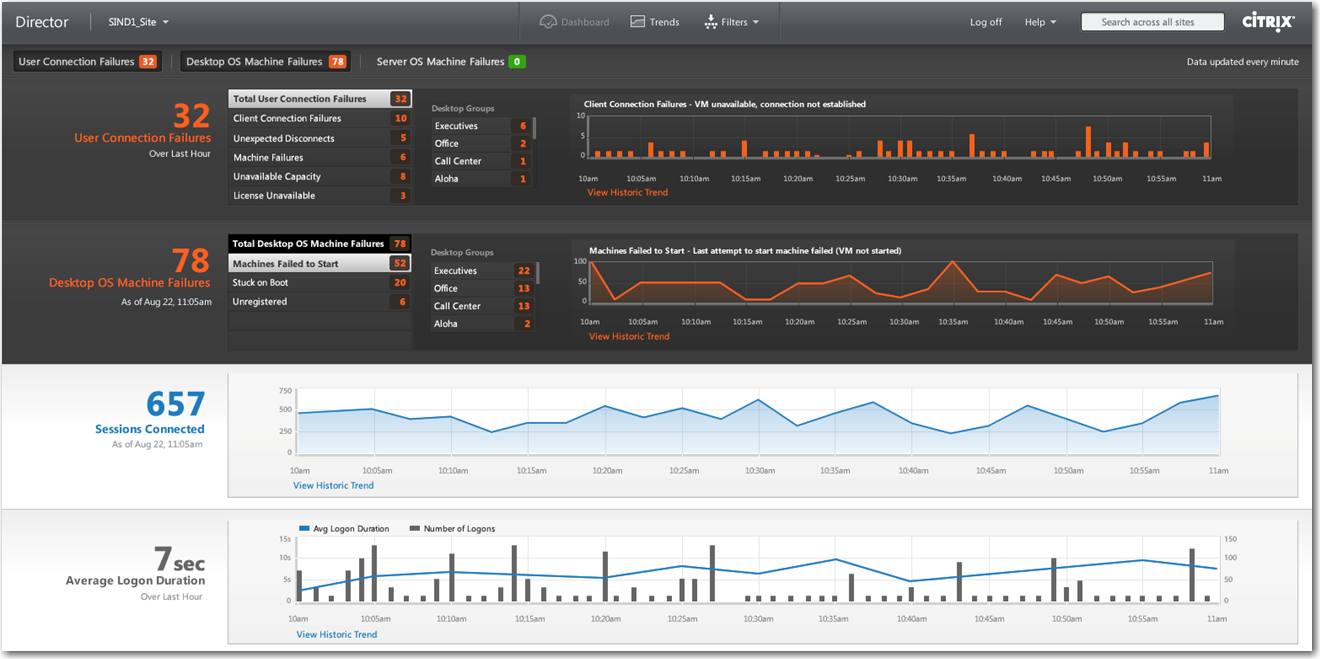
The following features are included in Director:
- Role-based access
- 7 days of historical reporting
- Up to one year of historical reporting
- HDX Insight
- All features in Director 7.6 except application usage
- Application usage
- All features in Director 7.6.100
- Session recording integration
- Framehawk support
- Integrated Windows Authentication (single sign-on)
- SCOM integration
- Desktop usage
- Proactive Notification and Alerting
- Logon Performance V2 (drilldown information per user of logon breakdown data)
- Storage I/O real-time utilization
- Disk Latency real-time utilization
- vGPU insights and real-time utilization
What are its limitations:
- Logon breakup is limited – doesn’t go into GPO processing time per GPO for example. EdgeSight used to provide a lot more detail. If WEM is used, Director doesn’t support WEM yet (can’t tell WEM processing time)
- Director needs a platinum license for historical data storage (beyond 30 days?)
- There is no visibility of all Citrix tiers (PVS, StoreFront, NetScaler, XenMobile, etc.) and no visibility of the supporting Citrix infra (network, virtualization, storage, AD, etc.)
- There are no synthetic monitoring capabilities (logon simulation)
- Since it does not have end to end visibility, Director cannot be used for root cause diagnosis
- And if you want custom reports, you need to write queries to the SQL database
Citrix Application Delivery Management – How far does NetScaler MAS go for Citrix XenApp and XenDesktop monitoring?
NetScaler MAS is a management and analytics platform for NetScaler devices. It can be used for consolidated monitoring for NetScaler devices. It also provides a lot of insights for web monitoring, SSL monitoring and others. For XA/XD monitoring, it provides HDX insight data. MAS looks at data from the network perspective (flows via NetScalers) and reports statistics. MAS breaks down latency into HDX latency and network latency. The network latency is further sub-divided into WAN and Data Center latency. This is very useful because Citrix admins have long had to deal with users saying Citrix is slow but they had no way of proving it is the network. With MAS, they can.
MAS cannot provide server-side visibility of Citrix servers. If there is a memory leak in a Citrix XenApp server affecting all session connected to it, MAS will not be able to detect the problem. There are no synthetic monitoring capabilities. And MAS does not look into the supporting infrastructure for correlated visibility (so it can tell that Citrix is slow but not always why it is slow).
What about licensing
You can add any number of NetScaler instances in NetScaler MAS. But if you want to monitor and manage more than the default free 30 vServers – you might have to upgrade your licenses on NetScaler MAS. Licenses for additional virtual servers are available in virtual server packs of 10.
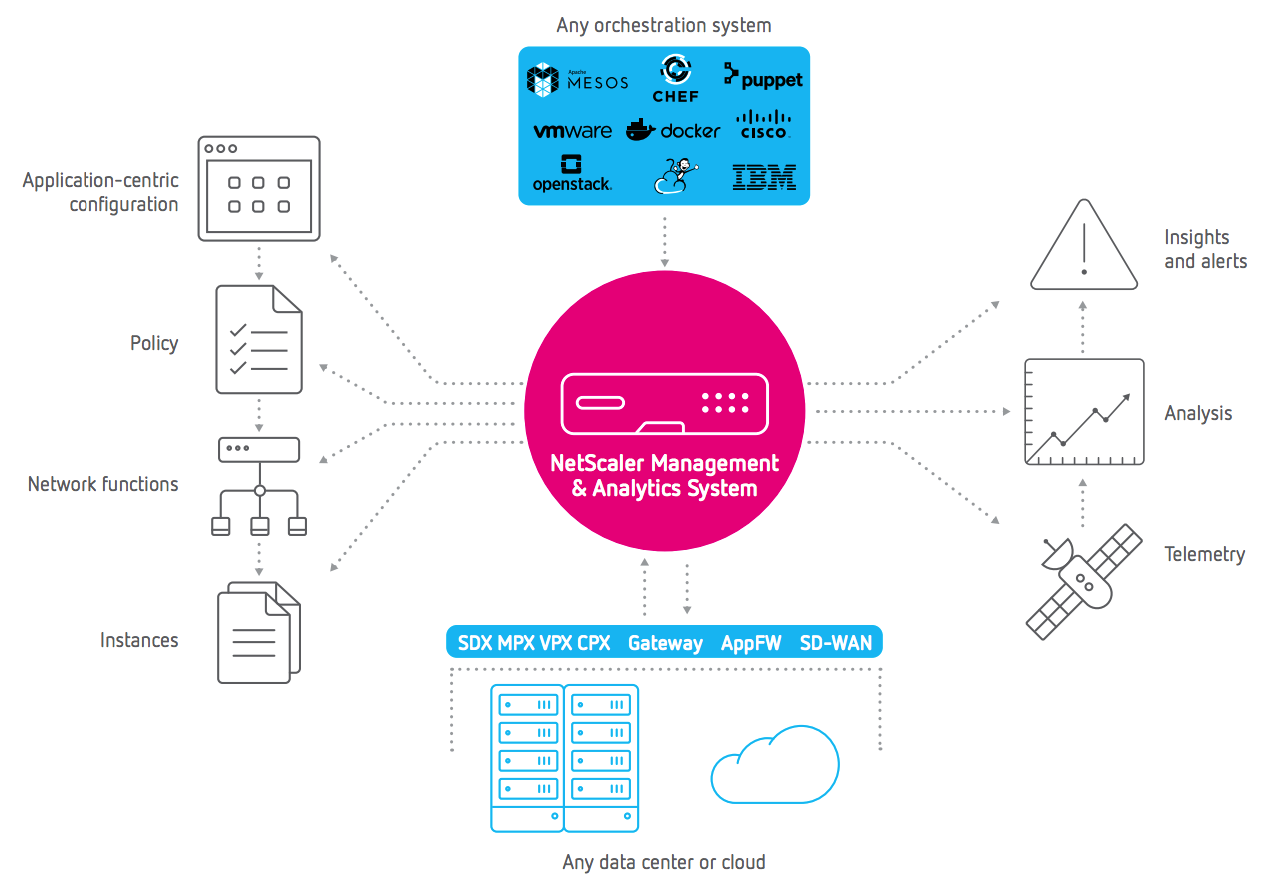 NetScaler MAS integrates with Citrix Director on a networking level. You can see the HDX traffic flows through the same web portal – by using the networking tab in Director. Note: You’ll need Citrix Platinum licenses to use that specific functionality.
NetScaler MAS integrates with Citrix Director on a networking level. You can see the HDX traffic flows through the same web portal – by using the networking tab in Director. Note: You’ll need Citrix Platinum licenses to use that specific functionality.
The following features are included in NetScaler MAS:
- Application Performance Analytics
- Application Security Analytics
- Advanced Analytics
- Networks
- Instances
- Instance Groups
- Event Management
- Certificate Management
- Configuration Management
- Configuration Audit
- Network Reporting
- Analytics
- Web Insight
- HDX Insight
- Gateway Insight
- Security Insight
- SSL Insight
- TCP Insight
- Video Insight
- WAN Insight
- Orchestration
- Cloud Orchestration
- SDN Orchestration
See the following article for a more detailed overview
Citrix Analytics is an entirely new product within the Citrix portfolio stack and offers insights to help administrators to combat modern-day threats, and use artificial intelligence to help enforce security policies – combined with Performance and Operations measurements analytics. The complete “Citrix Workspace” product portfolio will include Analytics by default – when you use Citrix Virtual Apps and Desktops, Citrix Files and User Endpoint Management (Old names: XenApp and XenDesktop, ShareFile and XenMobile), this will probably be fascinating for you. It easily integrates with other Citrix Cloud services to provide complete secure digital workspaces.
What about licensing
Additional add-on – standard included in Workspace Premium.
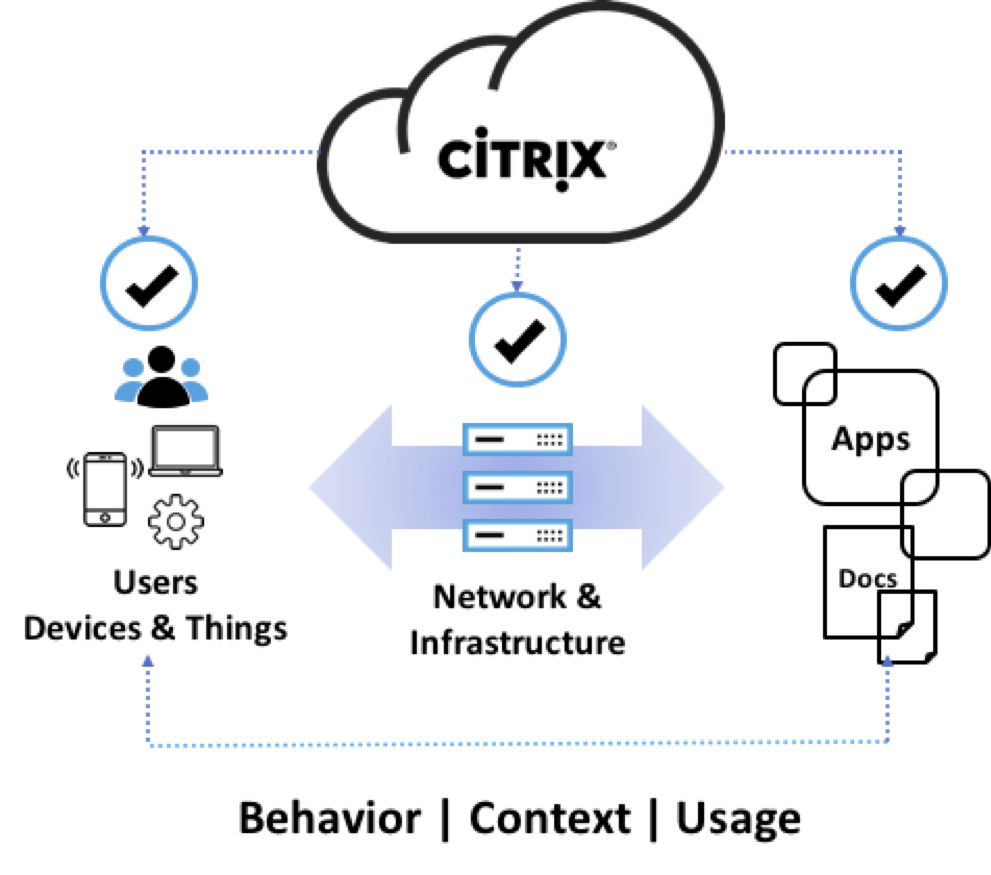
The Citrix Analytics Service will be available in 3 kinds of versions. The first up is Security and later Performance and Operations will follow as well. The dates when these other services will be released is still TBA.
I see the Citrix Analytics personally as Citrix Director 2.0 – Citrix will include more and more additional insights into Citrix Analytics, which you can use besides Citrix Director. You’ll get better insights than the Citrix Director can deliver. The Operations service will probably include more features which Director is delivering as of today. I’m very looking forward how this path follows within the next months.
The following features are included in Analytics:
- Handle user and app security threats before they happen.
- Uncover app and data usage trends.
- Improve app performance and support continuous operations.
- Automated aggregation of data and intelligent analytics using machine learning.
- Easy access and simple onboarding of multiple Citrix offerings.
- Deep insights that grow richer as more Citrix offerings are added as data sources.
It’s all about the context…
Combining Analytics with Citrix Unified Endpoint Management (UEM) / contextual access control solution, it opens a lot of new door in protecting your digital workspace!
Interested in Citrix UEM? Check out this video.
Significantly, Citrix Analytics allows organizations “to create policies that describe the business rules you want to enforce when those anomalies are detected.” You can create actions, which takes place when the user performance.
The users are listed in a dashboard, which is useful to track down subspecies activities through the Workspace environment. AR will terminate the user session or block access to individual files or locations to make sure no viruses or other vulnerabilities / activities can harm your users and environment.
Did this all made you curious, request a free Analytics trial here.
What about Citrix Management Packs for SCOM?
They are useful only if you have SCOM installed. To have them work, you need to have a Citrix platinum license. SCOM itself has no visibility into Citrix, this is where the management packs help. They collect metrics and report in the SCOM UI. For someone used to SCOM, it is useful. They can monitor Citrix now. The limitations are: Not useful if you don’t have SCOM. Not useful if you are not on Citrix platinum. Management packs have basic metrics but no great drilldowns. Also to get an end to end view, you need to have additional management packs – for VMware, storage, network, etc.
What about licensing
The only way to get the new Citrix SCOM Management Bundle is through XenApp and XenDesktop Platinum edition license.
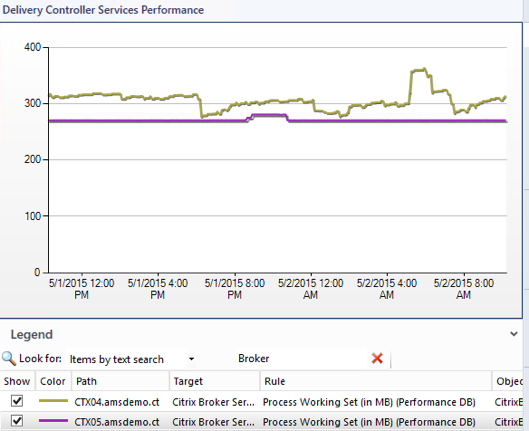
Is your IT team juggling responsibility of multiple sites and/or multiple delivery groups? Or are you a service provider catering to multiple customers? If you answered yes to either question, you will love SLA dashboards. They help you monitor Quality-of-Service for each site or delivery group.

What about monitoring of Citrix StoreFront, PVS, License server, WEM, XenMobile and ShareFile?
Each of these has its own console that provides key performance metrics for that tier. The limitation is – no single pane of glass where you can monitor everything Citrix.
What capabilities are needed for Citrix admins for performance troubleshooting, going beyond what native Citrix tools provide?
While built-in Citrix tools are good enough for monitoring individual parts of the Citrix delivery infrastructure, you need to look beyond Citrix built-in tools if:
- You want to monitor Citrix as a service (take an end to end view, so when a user says Citrix is slow, you can tell if the problem is one of the Citrix tiers, or VMware, or storage or network)
- You need a unified single pane of glass view into all of your Citrix tiers so you don’t have to go back and forth between different consoles
- You want to be proactive and have simulation capabilities set up to monitor your infrastructure
- You don’t have Platinum licensing and still need in-depth monitoring of Citrix XenApp and XenDesktop
What third-party tools should I look at for Citrix performance monitoring?
There are many Citrix Ready solutions available in the market. When looking for a solution, determine who is going to use the tool. For example, if you want a Level 1 support person to use the tool, they will not be Citrix experts. You want them to be able to quickly determine if there is a Citrix issue and if so, who to call to resolve the issue – the network team, or virtualization team, or Citrix team or the client team. This is where the topology maps and layer-wise drill-downs offered by the eG Enterprise product from eG Innovations, for example, can help. If you are managing a large Citrix environment, you may want problem alerts to automatically raise trouble tickets, you want the ability to put servers into maintenance mode, and other such capabilities. Also, consider the types of problems you are responsible for. For example, if a problem happens at 3 am and you get into the office at 8 am, you should have the ability to go back in time and see exactly what happened at 3am, so that you can find the root cause of the problem and fix it.
Historical data becomes critical for post-mortem analysis and problem triage. Use monitoring tools that include historical analytics to track trends over time, contextual analysis to isolate anomalies, and predictive capabilities to foresee impending issues will greatly accelerate performance troubleshooting. When your monitoring tool provides centralized visibility of all your Citrix tiers and the supporting infrastructure, you will be able to track performance and health status of your entire environment from a single pane of glass. Additionally, look for third-party monitoring tools, such as eG Enterprise and likely others, that have both synthetic and real user experience monitoring capabilities built in.
Is monitoring mainly about troubleshooting?
No. Troubleshooting is a common use case. But it is not the only one. For example, in healthcare or finance, reporting is very important. Admins need to be able to report on who logged in, for how long did they login, what applications did they use, what resources did they consume, etc. Having the ability to generate these types of reports is important. Furthermore, monitoring collects a lot of data – monitoring tools need to be able to analyze this data and provide recommendations for how you can optimize your infrastructure for peak performance and ROI.
Thanks for reading.
Cheers,
Christiaan Brinkhoff







